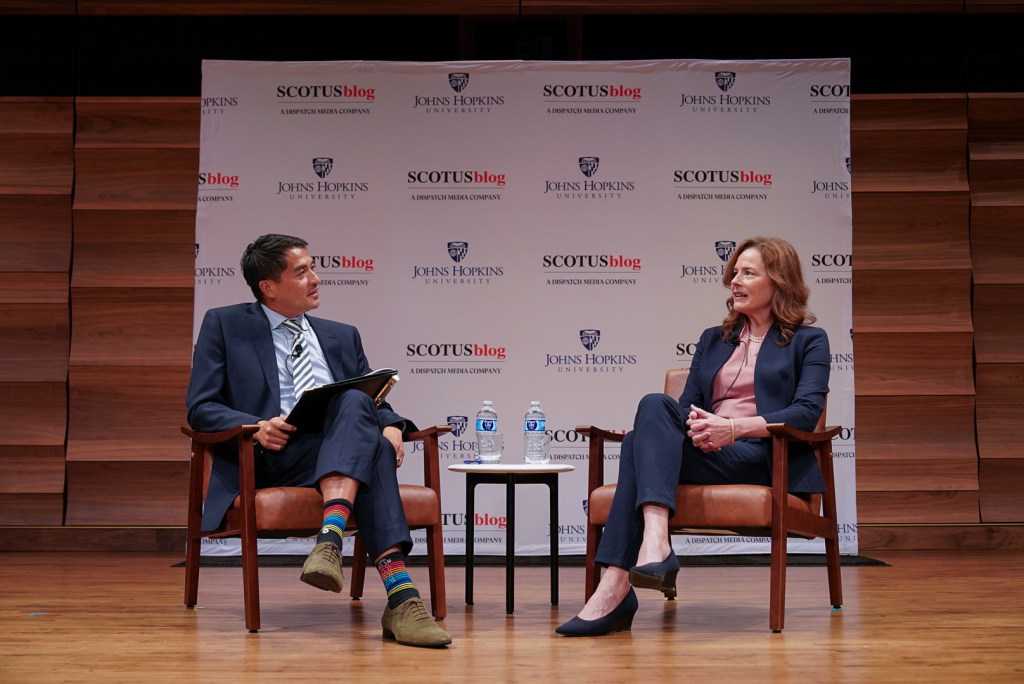Justice Barrett reflects on public scrutiny, swing votes, and recusals at SCOTUSblog Summit


Justice Amy Coney Barrett is not on social media to see critics calling her too conservative when she sides with her fellow Republican-appointed justices and too liberal when she doesn’t, but she’s well aware that not all court watchers are fans of her work. She’s seen protesters outside her house and knows that “criticizing the judiciary is as old as the institution itself,” she said on Thursday at the inaugural SCOTUSblog Summit.
“I’ve had to just learn to tune it out,” Barrett explained to Judge Patrick Bumatay of the U.S. Court of Appeals for the 9th Circuit, who interviewed her on stage at the Summit, because “it’s the job of a judge to ignore that and not be influenced by public opinion.”
Her training in tuning out criticism began soon after she was nominated to a federal judgeship. During the confirmation hearing for her appointment to the U.S. Court of Appeals for the 7th Circuit in 2017, then-Sen. Dianne Feinstein questioned whether Barrett’s Catholic beliefs would interfere with her work on the court. “The dogma lives loudly within you,” Feinstein said, sparking multiple news cycles centered on Barrett’s faith.
“I was surprised by it, and I was … a little uncomfortable to have my faith be in the spotlight after that hearing,” Barrett said of Feinstein’s comment. “But it’s a big part of my life so I’m not ashamed of it.”
It became clear on Thursday that the dogma question wasn’t the only part of her confirmation hearings that made Barrett uncomfortable. When asked by Bumatay to name some “highlights and lowlights” of the process of being confirmed to the Supreme Court, she said “it was pretty much all a lowlight.”
Barrett recalled psyching herself up for the intense scrutiny by listening to a playlist from one of her daughters. She said a lyric from a Rodney Atkins song on the playlist felt particularly fitting — “If you’re going through hell, keep on going.”
Barrett did keep going, and she’s now been serving on the Supreme Court for nearly five years. She said “judging is the kind of thing you’re always learning,” but added that she feels “very comfortable” on the court.

When Bumatay asked about her path to becoming a lawyer and then justice, Barrett explained that she was on the verge of choosing a different profession as late as her senior year in college. Growing up, she loved reading and “playing school,” so she seriously considered becoming a teacher.
Barrett described making pro-con lists during her senior year and taking admissions tests for both graduate and law school as she wrestled with whether to pursue a graduate degree in English or go to law school. She ultimately chose law school at the University of Notre Dame and “loved it,” but that doesn’t mean she thinks it’s the right fit for everyone. She said she recently discussed law school with her oldest daughter and thought it was “a good idea” when she decided to work for two years and then reevaluate her interest. “I’m not down on going to law school. I love law school. I think lawyers can have great careers and there are a lot of things you can do with a law degree, but I don’t think you should just do it [by] default,” Barrett said.
After completing two high-profile clerkships and then working for a firm, Barrett got an offer from Notre Dame that “seemed like a dream job.” She was able to teach and write while remaining deeply engaged with the legal world. To this day, Barrett continues to teach at Notre Dame when her schedule allows it, but she hasn’t been able to keep going to her old CrossFit gym, which she pointed to when asked what she misses most about life before her Supreme Court appointment. (“I’m in much worse shape [now],” she said, drawing laughs from the crowd.)
After asking about her upbringing and early professional life, Bumatay invited Barrett to discuss her current work, including her place on the court. She said that she doesn’t think of herself as a swing justice, because the label “makes it sound like you sort of are swinging back and forth and you can’t make up your mind.”
Barrett also doesn’t claim the label of “institutionalist,” although she noted that she thinks “the institution matters.” As a Supreme Court justice, “you’re not writing just for yourself … you are writing for a multi-member court. … I think we have to speak in an institutional voice and be protective of the institution, but I think my other eight colleagues would agree,” she said.
Barrett acknowledged that writing for a multi-member majority can be “frustrating” because “you have to leave questions unanswered.” “When you’re an academic, you’re writing for yourself. … You get to say whatever you want to say,” she said.
Another difficult part of the job is the problems it can create for other people. Barrett raised that issue when asked about how she decides when to recuse herself and whether to publicly explain such a decision – a practice that the court’s Democratic appointees have recently adopted, but Barrett has not. Barrett noted that if a personal relationship leads her to feel that she can’t fairly decide a case, she doesn’t want to identify that person and potentially put them at risk.
Posted in Court Analysis